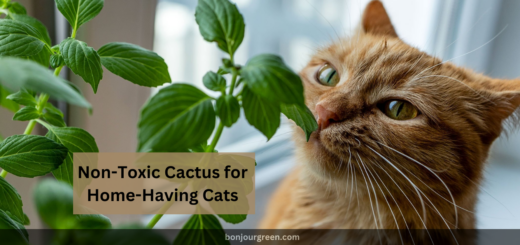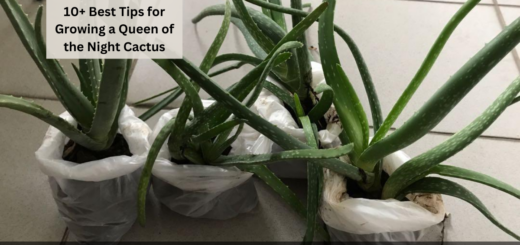Overwatered Cactus – Signs and Step-by-Step Solution
In this article, the readers will be acknowledged for how to know about the Overwatered Cactus, its Signs, and Step-by-Step solutions. These plants are loved by many people as houseplants too. But the issue arises that they get easily overwatered. We always stay confused regarding watering these cacti.
Quick takeaways:
- Cactus, a beautiful member of the family Cactaceae, are succulents that have spikes all around their body and store a lot of water in their leaves.
- Overwatering the cactus is more prone to getting root rot, fungal growth and infections, pest infestation, and even bacterial infections.
Now that you might have overwatered your cactus, you still can revive it depending on the reasons, signs, and conditions we will reveal below. Root rot is a critical situation where the chances of saving the plant are less if the root has been destroyed badly and it is one of the reasons the cactus starts turning brown. Otherwise, you can get back the cactus plant and get them growing like before.
What happens when you overwater a cactus?
As written above, the overwatered cactus are more prone to getting root rot, fungal growth and infections, pest infestation, and even bacterial infections. You will also see the discoloration and mushy plant appearance if they are overwatered.
Overwatered cactus vs. underwatered cactus
Unless the cactus plant is ignored for long in a very dry area having high temperatures and hot winds, they don’t get submerged as they use up the stored water. But the cactus getting overwatered is a really common problem though both of these conditions indicate some symptoms which can be the same. So let’s tell you the difference
The overwatered cactus plant will show fading leaves which means the lush green color will turn to a yellow or brownish shade. The cactus will look squishy and dull.
The underwatered cactus look lifeless and dry with the wilting of the leaves. The plant will not appear to grow further with the roots that also shrink and become cracked. Even though the soil is not too soggy there are chances that cactus is being overwatered as they are succulents and need very less amount of water.
For more such plant related-articles, you may also read, Overwatered Lemon Tree – Signs and Step-by-Step Solution
The soil for the overwatered cactus will look soggy, wet, and moldy whereas the soil in the underwatered cactus will look dry, and faded.
How does overwatering of cactus happen?
The cactus can be overwatered if they are placed outside and the rainfall has overflown the pot. Rain can make the plant drenched in water and soil soggy. While watering the plants through a pipe there are chances that you can overwater the cactus plant. The other reason can be that you are watering the cactus too often and not letting the water get dried first.
The poor drainage can be the culprit that you are watering your cactus right but the plant is still squishy as the water isn’t getting drained and the soil stays wet for long. The season needs to be looked upon while watering the cactus.
The cactus needs very less water like two times in 30 days during the winter season. The summer heat makes the cactus plant more thirsty when water needs to be given every week one time.
The high humidity can reduce the evaporation of water and make the plant get mushy too. The water droplets on the leaves should be noticed which means there is high humidity. The overwatering of cactus can even happen due to the high moisture in the air which is not letting the plant get dry.
Signs that overwatered cactus indicate
Go through all the symptoms that the cactus plant indicates and it is important to tackle these as soon as possible. The cactus being overwatered needs to be dried otherwise the plant might die. Overwatered cactus are low maintenance and easy to care for, but the house plants like cactus need to be checked daily. Following are the signs that the overwatered cactus show.
- The appearance of the plant changes
- Root rot
- Discoloration of leaves
- Black circular and brown spots on the leaves
- Unpleasant smell
- Fungal infections
- Dropping of plant
- Soggy soil
- Wilting of cactus leaves
- Moldy soil
- Plant color changes as well
- Edema
How to revive the overwatered cactus?
Repot the plant
The cactus plant that is overwatered in many cases has root rot as the excess water damages the roots and causes fungal growth around the cactus plants and will turn the cactus white. Take the plant out of the soil and examine the roots properly for rot. The soil needs to be washed or brushed away, and the roots that are destroyed need to be removed or cut down. Let the roots dry and repot a plant into the new pot.
Dry the plant
Move the plant to a spot with good sunlight and less humidity, so that the extra moisture can be eradicated and the plants get dried. Make sure to give sunlight to the plant for at least an hour and exceed the time depending on the sogginess of the cactus plants.
Stop watering the plant
The cactus plant needs to be given a break for some time. The watering needs to be stopped as soon as possible. No further watering! The cactus plants don’t like much water and if the soil is still appearing wet and moist that means the plant should not be given water. Let the water get drained properly and then water the plant.
Remove the affected plant parts
The cactus plants that are overwatered show molded leaves and roots. The damaged leaves should also be removed as they are more susceptible to infection and pest attacks. These leaves can harm the other leaves of cactus plants. Also if you notice the spots on the leaves, don’t take the risk and remove these leaves as well.
Use a good pot and potting soil
If you are repotting the cactus plant then make sure that the pots are of the right size, and the pot has a good number of drainage holes. The drainage should be good. If the pot does not have holes you can make some holes in the soil by yourself. You can also add some sand to the soil to increase the drainage annuity of the soil. Place the pot in a spot that has a good amount of sunlight, water the cactus plant, and set the schedule of water. Avoid fertilizing too much.
Final words of the context
Overwatered cacti can be saved by drying up the plants just like the pothos are saved giving them good sunlight, removing the affected, and cutting back on the water supply for some time. The cactus plant can be saved if the roots are not severely damaged. You need to work on the drainage and improve the soil as well. Avoid using moldy or unhygienic soil which can call for infections in the cactus plants. We hope you liked this article and find it helpful. Happy planting!


